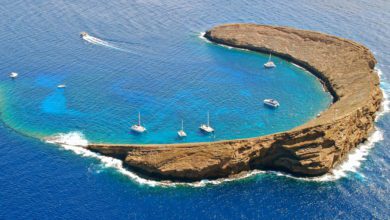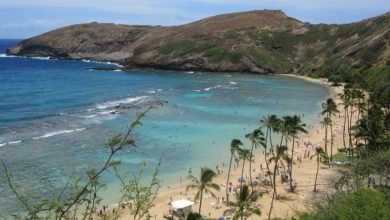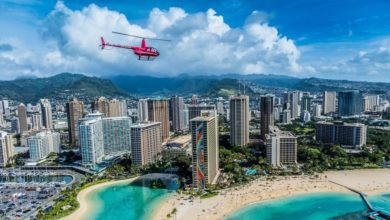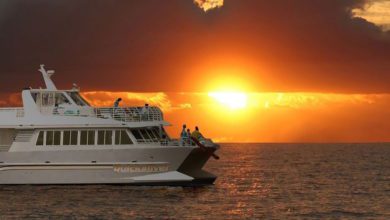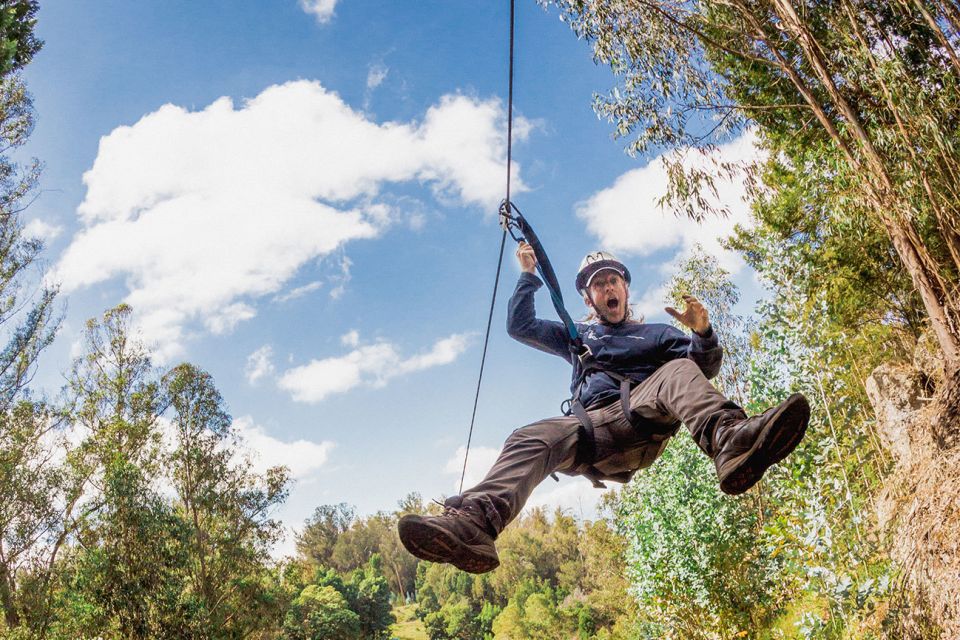
With its tropical forests, waterfalls, and mountain views, Maui is a perfect destination for zipline tours. In fact, you can find America’s oldest zipline course in Maui. If you are visiting Maui, ziplining is a wonderful activity to experience.
There are many zipline excursions in Maui, but they are not all the same. Some are combined with hikes and visits to picturesque waterfalls. Others focus entirely on a Maui ziplining adventure. Because every traveler is unique, you should examine each of the available ziplining trips in Maui and choose the one that is best for you and your family’s needs.
We have selected the top-rated zipline tours in Maui and examined what each of them has to offer. You can read our reviews below.
Best Ziplines in Maui
| Maui: 7 Zip Lines and WWII Museum | Maui: Ka'anapali 8 Line Zipline Adventure | Maui: Zipline and Waterfall Hike | |
|---|---|---|---|
 |  |  | |
| Meeting Point: | NorthShore Zipline Co., Kauhikoa Road, Haiku | NorthShore Zipline Co., Kauhikoa Road, Haiku | Kahului Park and Ride |
| Starting Times: | 3:45 PM, other times sometimes available | 8:00 AM, 9:00 AM, 12:00 PM, 1:00 PM | 9:30 AM |
| Duration: | 2 hours | 3.5 hours | 6 hours |
| Includes: | 7-ziplines tour, extensive zipline training, safety equipment, safety shoes, photographer, and water | 8-ziplines tour, safety equipment, and guides | 5-ziplines tour, private trails, 2 waterfalls, safety equipment, snacks, lunch, water, and guides |
Quick Answer: The 5 Best-Rated Zipline Tours in Maui For 2022
- Maui: 7 Zip Lines & WWII Museum
- Maui: Ka’anapali 8 Line Zipline Adventure
- Maui: Zipline & Waterfall Hike
- Maui: Haleakala 5-Line Zipline Adventure
- Maui: Small-Group Waterfall Hike and Zip-line with Lunch
Zipline Tours in Maui Reviewed
#1. Maui: 7 Zip Lines and WWII Museum

- Meeting Point: NorthShore Zipline Co., Kauhikoa Road, Haiku
- Starting Times: 3:45 PM, other times sometimes available
- Duration: 2 hours
- Includes: 7-ziplines tour, extensive zipline training, safety equipment, safety shoes, photographer, and water
This is the best zipline tour in Maui for wholesome family fun. Safety and training are a key element of this tour, making it a fantastic choice for children, first time zipliners, and anyone who is nervous. The tour involves a series of 7 ziplines, suspension bridges, and aerial transfer platforms.
While on this Maui zipline excursion, you will enjoy breathtaking views of the ocean and Maui’s lush northern shoreline. In the opposite direction, you will view Maui’s up-country landscape. The suspension bridges and ziplines transport you through a canopy of giant eucalyptus trees.
The final zipline is called Top Gun. Here you can reach speeds of up to 45mph.
Before you begin, there will be a brief talk on safety and procedures to ensure your fun isn’t disrupted by any accidents. Your experienced guides will provide all the necessary safety gear and ensure you’re ready to ride.
You will also be instructed in riding techniques. You may like to try a variety of sitting positions, including backwards, sideways, and spinning. To complete your training, you’ll test out your skills in the Base Camp where you will take a test run on the Trainer Line.
After graduation, you’ll be allowed out onto the big ziplines. However, the guides won’t be far behind. They will follow you along the route to ensure your safety and entertain you with games and jokes en route.
During your tour, professional photographers will capture action shots. The photographs will be available to view and to purchase should you wish.
As an additional bonus, this tour is located in the WWII Marine Pacific Training Base. You will have the opportunity to learn all about the history of the base and its role in the war.
For tour prices, transportation and availability:
#2 Maui: Ka’anapali 8 Line Zipline Adventure
- Meeting Point: NorthShore Zipline Co., Kauhikoa Road, Haiku
- Starting Times: 8:00 AM, 9:00 AM, 12:00 PM, 1:00 PM
- Duration: 3.5 hours
- Includes: 8-ziplines tour, safety equipment, and guides
This is the best Maui zipline adventure for wonderful views of the West Mau Mountains, the Pacific Ocean, and offshore islands. The tour is located in a remote area, and the experience begins with a short hike through the breathtaking landscape.
The 8 ziplines along the tour route are arranged in order of length and difficulty so you’ll become more experienced and confident as the tour continues. These ziplines are a little more challenging than those in the previous tour. There are short hikes between the ziplines, so you will benefit from additional views of the Pacific and the mountains.
Experienced guides will accompany you on the hike and tour. As well as ensuring your safety and helping with technical issues, your guides will teach you about Maui’s ranching history, culture, and environmental wealth.
This tour operator is especially concerned about the local environment, so a proportion of the revenue is donated to local environmental non-profit organizations. You can rest assured you’ve chosen a high-quality excursion because this is an award-winning Maui zipline tour.
For tour prices, transportation and availability:
Other Experiences You May Enjoy:
#3. Maui: Zipline and Waterfall Hike
- Meeting Point: Kahului Park and Ride
- Starting Times: 9:30 AM
- Duration: 6 hours
- Includes: 5-ziplines tour, private trails, 2 waterfalls, safety equipment, snacks, lunch, water, and guides
This is the best Maui zipline tour for people who wish to admire the beautiful scenery along the northern shore. This Maui zipline excursion includes waterfalls and a hike through the rainforest.
This wonderful excursion begins with a drive along the Hana Highway, the oldest road in the United States. This road was first constructed by King Pi’ilani over four hundred years ago. It is famous for utilizing 59 bridges over its 64.5-mile length.
The Hana Highway winds through the rainforest that hugs Maui’s northern shoreline, mostly only one lane wide with many sharp twists. At an especially scenic point along the route, you’ll climb out of your bus to enjoy an eventful hike.
During your hike, your naturalist guide will teach you about the local flora and fauna. At the end of the hike, you’ll reach two picturesque waterfalls. If you wish, you can jump into the water and swim in the plunge pools beneath the falls.
After the waterfalls, there will be a short break to eat the lunch provided. From the waterfalls, you’ll be transported by bus to the remote location of the ziplines. The Haleakala Zipline course was the first zipline adventure built in the US. Along the course, you’ll enjoy 5 ziplines and an Indiana-Jones-style rope bridge.
This Maui zipline trip strongly emphasizes exploration of the beautiful wilderness areas. If you want to see a side of Maui that has not significantly changed after European contact, this is the best zipline tour for you.
For tour prices, transportation and availability:
#4. Maui: Haleakala 5-Line Zipline Adventure
- Meeting Point: Haleakala Highway
- Starting Times: 8:30 AM, 9:30 AM, 11:30 AM, 12:30 PM, 3 PM
- Duration: 1.5 hours
- Includes: 5-ziplines tour, swinging bridge, all safety gear & instruction
If you just want to enjoy a Maui zipline adventure without any side trips, this is a fantastic value experience for the whole family. This thrilling zipline course features 5 exciting ziplines and a bridge situated on the slopes of Mount Haleakala.
Haleakala is a massive shield volcano so tall that it has a different, much cooler climate at its peak. The 5 ziplines offer picturesque views of the eucalyptus forest and surrounding mountain terrain. With speeds exceeding 40 mph, they’ll also get your heart racing. Each successive zipline is longer and more exhilarating than the one before.
The Indiana Jones style swinging bridge is a great feature in this zipline excursion. Tread carefully as you cross this moving platform through the forest canopy in upcountry Maui.
This Maui zipline tour operator is fully committed to sustainable tourism. Because of this, a proportion of the fees paid are donated to the 1% For The Planet campaign. These monies are used to fund local not-for-profit organizations that improve the environment and help local people.
This is a fantastic Maui zipline adventure for families who want to enjoy ziplining and see some breathtaking local scenery. It is an experience to remember.
For tour prices, transportation and availability:
#5. Maui: Small-Group Waterfall Hike and Zip-line with Lunch
- Meeting Point: Kahului Park and Ride
- Starting Times: 9:30 AM
- Duration: 6 hours
- Includes: Small-group tour, 5-ziplines tour, hike, waterfalls, safety equipment, snacks, lunch, water, insect repellant, poncho, and expert local guides
This is the best Maui zip-line adventure if you want to explore places only the locals know on an exclusive hike at the foot of Mount Haleakala. It is a small-group excursion, ideal for family and friend groups. This zipline tour in Maui includes a 5-zipline course, a scenic hike, and a visit to picturesque waterfalls.
This memorable, day-long adventure begins with a drive along the famous Hana Highway, the oldest road in the US built by royal decree. Hold your breath on the infamously sharp bends and admire the many geological features and dozens of bridges along the way.
The highway borders a spectacular stretch of tropical rainforest. Your local guides will take you on a guided hike through this eucalyptus forest and show you sights only Hawaiians can find. This highlight of this hike is a visit to the waterfalls.
The waterfalls are a wonderful place for fun in the water. You can jump from the top of the waterfall into the deep plunge pool or just splash around at the bottom. If you like, take a natural shower under the refreshingly cool water.
At the zipline course, you can enjoy 5 different ziplines, each longer and more exciting than the one before. You’ll swoop through the forest canopy 90 feet above the ground reaching speeds over 40 mph. The zipline course also features an Indiana Jones style swinging bridge, so take a deep breath and hold on tight to the supports.
This zipline excursion in Maui also provides a nutritious lunch and bottled water, so you won’t need to worry about anything. Just enjoy your day exploring the most beautiful landscapes in Maui.
For tour prices, transportation and availability:
Maui Travel Guide
When Polynesian adventurers found and settled the previously uninhabited island of Maui, they thought they had found Paradise. You will too!

There is so much to see and do on this compact island that you are spoiled for choice. You can go whale watching, climb a volcano, hike through tropical rainforest, and learn how to hula dance from professionals.
Before you go, it is in your interest to fully research the accommodations, transport arrangements, local foods, and attractions to ensure you get the most out of your visit. This guide is designed to help you on your way.
Airports & Entry
Most visitors to Maui arrive on an airplane or a cruise liner. Using either method, you’ll most likely arrive in Kahului.
Kahului is the main settlement on Maui, hosting its commercial shopping centers, light industrial areas, a deep-draft harbor for cruise liners, and Kahului Airport.
Although Maui only boasts a population of 155 thousand, over 5 million passengers pass through Kahului Airport every year. Many flights from the mainland involve a layover in Honolulu, but there are direct flights.
When booking, try to get a direct flight to save time. There is only one terminal building at Kahului, but you can find all the usual amenities on the second floor.
The Visitor Information Office in the central building is open from 7:45am to 9:45pm, and there are information desks throughout the airport.
ATMs and internet stations are found throughout the second floor. The airport shops—a DFS, gift store, jewelers, and newsstand—open at times varying from 6am for the newsstand to 8:45am.
All the shops close around 9pm. While the earliest of the 9 food outlets—Starbucks—opens at 5:30am, they are all closed by 10:30pm.
There are 8 car rental companies operating from the airport, but it’s a good idea to book in advance to save time at the airport and ensure that there’s a vehicle available.
A convenient and affordable shuttle service connects the airport to the main tourist accommodation locations on the island, including Wailea, Napili, Makena, Lahaina, Kihei, Kahana, Ka’anapali, Honokawai, and, of course, Kahului’s commercial center.
The Maui Airport Shuttle Service desk can be found in the Baggage Claim area, and no reservations are required. The desk opens at 5:30am and closes after the last flight arrival of the day.
If you are traveling light, the local public transportation system is an affordable option. Cash fares on the Maui Bus service are $2 per person for a single ride or $4 for a day pass.
Route 35 (Haiku) and Route 40 (Upcountry) operate every 90 minutes from 5:30am and 6:00am to 9:40pm and 10:11pm respectively.
However, the public bus has a strict luggage policy, so only one suitcase or carry-on bag is allowed and must fit on the passenger’s lap or under their seat. So, Maui Bus is only an option if you are a “hand luggage only” kind of flyer.
Taxis pick up from the front of the baggage claim area, but they are expensive. The metered rate is $3:00 per mile. That means it would cost you approximately $65 to Makena, $78 to Lahaina, and $105 to Kapalua.
Cruise ships moor at Pier 1 in Kahului Deep Draft Harbor. Maui Bus operates a service that stops at the harbor, and taxis are an option.
It is a 25-minute walk from Pier 1 to the Queen Ka’ahumanu Center, Kahului’s main commercial center and transport hub.
Traveling in the time of Covid
Like many other destinations worldwide, tours and visitor attractions in Maui have adopted special procedures.
Wearing a mask in mandatory in many locations. You will be expected to supply your own mask and wear it when you enter public buildings.
Keep your distance from other visitors who are not in your family group or bubble. You will be expected to keep your distance inside minibuses and other vehicles and when seated in restaurants.
At the time of writing, the State of Hawaii welcomes visitors but requires pre-travel testing for Covid-19. You can obtain the most up-to-date information directly from the State of Hawaii Portal.
Eco-Tourism and Sustainability in Maui
The Hawaiian Archipelago offers many areas of outstanding natural beauty and protected wildlife areas you can explore. In order to maintain this wonderful place for future generations, many of the local tour companies operate eco-friendly tours.
When considering the tours we review on the World Travel Guides website, note that there are often eco-friendly options that empower you to become a more sustainable traveler. This is especially true around the islands of Hawaii. Take care of our world and it will take care of our children.
Ziplining in Maui
Maui is volcanic in origin. Over the course of thousands of years, two massive shield volcanoes formed side by side and merged into one large island. These steep-sided volcanoes provide dramatic slopes and breathtaking views, perfect for zipline courses.
The rainforests at the bottom of the volcanoes are filled with fragrant eucalyptus trees. Many ziplines are designed to fly you through the forest canopy so that you get a unique bird’s-eye view of the trees and surrounding scenery.
Because Maui is a perfect location for ziplining adventures, the oldest ziplining course in the US is found there. While you are visiting Maui, ziplining is a wonderful activity to experience.
Planning Tips
It’s always best to be prepared. Here are 5 tips to help you make the most of your stay on Maui.
Tip #1: If you want to see whales, go in winter
During the summer, humpback whales feed and congregate around Alaska. In winter, they migrate south to mate and calve. From mid-December to mid-April, there are an abundance of whale sightings in Maui.
Between 10 and 12 thousand whales congregate in these tropical waters. Whales are often visible at a distance from the beaches and will circle any small boats that approach their pods. Winter is the best time to whale watch in Maui.
Tip #2: Take your time to appreciate all that Maui has to offer
Perhaps you only want to see the whales or surf in the sunshine, but there’s a lot more to see and do in Maui.
Don’t miss the opportunity to climb a volcano, explore inside a lava tube, experience a traditional luau, and visit the historical royal town of Lahaina. See the information on Nightlife and Attractions below.
Tip #3: Book Maui tours in advance, especially during winter
Maui is a popular destination for tourists, so tours quickly sell out. Book in advance to avoid disappointment. You wouldn’t be able to forgive yourself if you went all that way only to miss your opportunity to whale watch because the tours were full.
Since many tours offer free refunds up to 24 hours before the activity begins, you’re not taking a risk if you book before you go. Just check the refund policy of each tour before you book.
Tip #4: Take summer clothes and raincoats
Because Maui is tropical, you need to pack summer clothes. However, don’t forget it also rains a lot on the island.
Light raincoats are an excellent idea. If you intend to see the sunrise or sunset from the top of Haleakalā, you will definitely need a jacket.
And if you plan to visit a plush Martini lounge or attend a luau, you should bring something a bit smarter for those special occasions.
Tip #5: Buy traditional local craft souvenirs
If you want to take home something unique, check out the Maui Crafts Guild in Paia, a small settlement a little east of Kahului just off the Hāna Highway.
This store is a member owned and operated cooperative where you will find the actual artists inside the store eager to speak to you about their arts and crafts.
Restaurants & Eating Out
Maui not only has a unique ecosystem with plants not found in the other 49 States, but it also boasts an uninterrupted cultural history.
That means during your stay you have the unique opportunity to taste genuine Polynesian food untainted by European colonial influences.
Because Maui is an island surrounded by abundant marine life, it’s no surprise many restaurants feature seafood on their menus. A popular dish is Opakapaka, which is crimson snapper either steamed, baked or grilled.
Monchong is a deep-water fish marinaded and grilled. Raw tuna is a favorite with the locals and is found in traditional foods like Poke.
Poke is like Japanese Sashimi but with the raw fish served in hearty chunks rather than thin slices.
Something unique to the Hawaiian Islands is luau food cooked in an earth oven called an imu. A tasty example of luau food is Laulau, made with pork, chicken, or fish.
The selected meat is wrapped in taro leaves and then cooked inside the imu for hours until it grows soft with a smoky taste. Delicious!
While many North Americans might consider either bread or potato to be their staple food during meals, on Maui taro is the staple root crop.
Taro is most often consumed as Poi, a thick paste that is either baked or steamed. Poi is slightly sour due to fermentation during its preparation.
And for dessert, why not try some Banana-Apple Fruit, Breadfruit, or Kulolo. Banana-Apple is a common fruit eaten cold or hot. Breadfruit is melon-sized and is served boiled, deep-fried, baked, or steamed.
Kulolo is steamed taro pudding. Yes! Taro is a versatile root.
Nightlife & Entertainment
Despite Maui’s small size, you will find a good selection of venues to let your hair down. The island offers something for everybody’s taste, from a plush Martini lounge to a rowdy beach watering hole where locals play pool and watch the big game live. But something truly special only experienced in the Hawaiian Islands is a luau.
If you want to dress up and drink in style, you could head to the Ritz-Carlton in Kapalua and visit the Alaloa Lounge. They offer outdoor or indoor seating and live entertainment Thursday through Monday. The Kapalua Martini is a local specialty you should try.
At the other end of the scale is Life’s A Beach in Kihei, a beach lounge frequented by locals. As well as the football and pool tables you’d expect from a popular watering hole, they also have regular evening entertainment. They offer everything from open mic nights to live reggae bands.
But for a fun-packed evening of traditional songs, stories, food, and drink, you won’t do better than an organized traditional luau.
For around $130, you can experience Lei Greetings, observe the Imu Ceremony (cooking a pig in an earth oven), Hula Dance, and play Hawaiian games. The highlight is a performance by locals telling the story of how their ancestors first discovered and populated Maui, aided by the gods.
Getting Around
If you want to explore the Hāna Highway with the flexibility to stop wherever and whenever you choose, your best option is to rent a car.
However, if you don’t want to do this, you can get around by public transportation, shuttle bus, on a tour, or by taxi. Maui Bus, the public bus service, is an extremely efficient and cheap way of getting around the island.
But Maui Bus’ focus is on getting the locals where they need to go, which might not be what you want to see. A tour bus will take you exactly where you need to go, but on their schedule, not yours.
Taxis are an option for nearby attractions, but at $3 per mile, they are expensive for long journeys.
Accommodations
Most visitors to Maui stay near one of the larger settlements along the coast, but not Kahului, which is relatively industrial and less touristy than other towns.
Popular locations include Kā’anapali, Kapalua, Kihei, Lahaina, Mākena, and Kapalua. There are also hotels and resorts in the Up Country area around Kula.
When deciding where you want to stay, think about what you most want to see and do while you’re on the island.
Bear in mind that towns like Kā’anapali, Kapalua, and Lahaina on the leeward, west coast will be a lot drier and a little warmer than towns like Hāna on the windward, east coast.
Also remember that although the island is small and settlements close to one another, the roads meander, and there are mountains in the way. If you decide to stay in Hāna but intend to visit Lahaina, allow 3 hours each way for the drive.
When you’ve chosen your target location, you will find lots of resorts, hotels, hostels, and B&Bs to choose from. Tourism is big business in Maui, so there are rooms available to suit any budget.
Weather
Although Maui is a small island, you will experience several distinctly different climates while traveling around. This is a product of the island’s unique geography.
There are two important variables: elevation above sea level and position in relation to the two mountainous regions.
If you are on one of the whale tours in Maui, your boat will be at an elevation of 0 feet, but if you are admiring the view from atop Haleakalā, your elevation is 10,000 feet.
The higher you climb, the cooler the air temperature will be. As a rough guide, every 1,000 feet you rise above sea level, the temperature will drop 3.20F.
This means that when the beach is 700F, the summit is 380F! Although Maui’s climate is tropical, snow sometimes appears at the summit.
If you decide to climb Haleakalā, make sure you take warm clothing in your backpack. You may begin your ascent in the tropics, but you’ll arrive to weather more like the Arctic.
Up Country Maui is wetter and cooler than neighboring South Maui because it sits at a higher elevation.
The low-lying central valley, where the airport is situated along with Kahului and Maalaea, is windy but dry and usually sunnier than other areas. The trade winds hit the windward, eastern shores of the island, bringing moist air.
As that air climbs the mountains, it releases the moisture as rain. This leads to a lot of rain on the east side of the island, hence the rainforests.
The leeward, western shores, because they are sheltered from the wind by the mountains, only get a remnant of the rain. This makes the western shores relatively dry, especially where sheltered by Haleakalā.
The average temperatures on Maui don’t change too much from the winter to the summer. Because the island is in the tropics, it’s almost always warm. In the coolest winter months, the average high is 800F and the low 650F, but around 10F cooler along the Hāna Highway.
If you want to snorkel, the ocean temperature is a pleasant 750F. Winter is the season that sees the most rainfall. In the warmest summer months, the average high is 840F and the low 700F but 830F-690F around Hāna. The ocean temperature rises to around 800F in summer.
Attractions
Maui is an island steeped in natural beauty and cultural history. There are many interesting places to visit and activities to enjoy.
You can hike through the rainforest, snorkel in the crystal-clear water offshore, watch whales in the Pacific, or attend an authentic luau.
Maui is volcanic in origin, created by lava flows from two volcanoes. Haleakalā is the larger of the two volcanoes, responsible for over 75% of Maui’s landmass. You can find Haleakalā at the heart of Haleakalā National Park, which is a popular destination for tourists.
If you enjoy photography, you’ll love the sunset over the Pacific Ocean viewed from the summit of Haleakalā. And once the sun has gone down, Haleakalā is also a fantastic place to stargaze, when it is not cloudy.
At 10,000 feet elevation and with no light pollution, you get an uninterrupted view of the cosmos. The main feature of the park is the volcano’s crater.
It is 7 miles long, 2 wide, and approximately 2,600 feet deep. Another popular attraction inside the park is Hosmer’s Grove.
This is an unusual collection of invasive trees from all around the world, including eucalyptus from Australia and pine from North America.
Visitors love to explore the Hāna Highway—Hawaii Routes 36 and 360. The highway winds along the North Shore between Kahului in Central Maui and Hāna in East Maui.
Built by King Pi’ilani in the 16th century, this ancient road has a longer history than the Union. It is only 64½ miles long but features 59 bridges, most only one lane wide, and many sharp bends.
Driving along the highway, you will frequently stop to photograph the lush tropical rainforest. You can also visit waterfalls, walk along stunning black-sand beaches, and view scenic mountains.
However, if you decide to travel this route, expect delays. Even without stopping, the drive between the two towns takes 2½ hours.
Over in West Maui, the most popular destination for hikers is Iao Valley State Park. This is a stream-cut valley within the tropical rainforest, which features a distinctive natural landmark. Rising 1,200 feet from its base, the Iao Needle is a stunning basalt formation.
Not far away, on the north coast, you can find Nakalele Point. This scenic area of cliffs is famous for its blowhole, which spouts jets of seawater 100 feet into the air like a geyser.
Tourists fascinated by the cultural history of Maui flock to Lahaina, the largest settlement in West Maui. Once the residence of the royal family, Lahaina was the capital of the Kingdom of Hawaii from 1820 to 1845.
Here is where you’ll find the oldest buildings and learn about local history. Lahaina still projects the ambiance of a 19th-century whaler’s seaport.
The settlement’s historic district boasts 9 important historical buildings built between 1823 and 1901. The 1859 Court House was constructed over the site of the royal palace, and the United States Marine Hospital dates to 1842.
Banyan Tree Park occupies the site of the 1831 Lahaina Fort and features the largest banyan tree in Hawaii planted in 1873.




